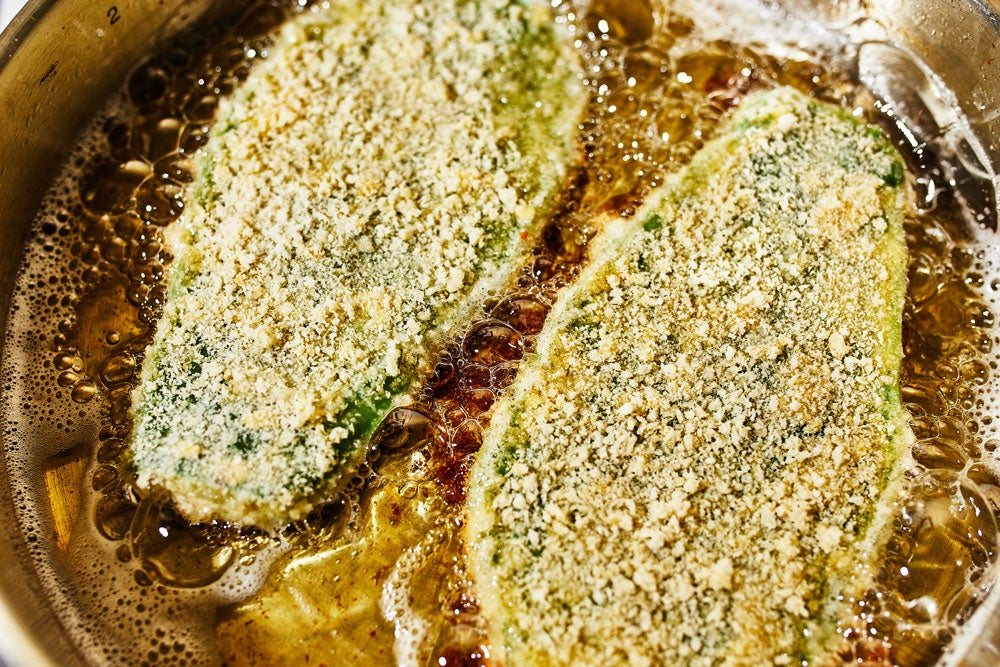If there’s a silver lining to spending the better part of 2020 trudging through the cooking of three meals a day with limited groceries and brainpower, it may be the realization that you don’t need an industrial deep fryer to turn a chicken breast into an absurdly crispy, plate-size masterpiece—so perfectly golden that it seems to actually be glowing. You don’t even need some kind of top-secret Popeyes-grade batter recipe. You just need a frying pan, some crumbs, and a bit of cutlet know-how.
The basic premise behind a cutlet, Milanese, schnitzel, katsu—however you choose to call it—is pounding a piece of meat very thin, breading it, and frying it for a couple minutes per side in a shallow pan of butter or oil. It’s a conceit so simple, with such a high reward, that it’s entered the weekly dinner rotation for almost all of my coworkers as a sub-ten-minute non-recipe that doesn’t need much more than a lemon wedge, a few greens, or a drizzle of vinaigrette to make it feel like a complete package.
The protein can stretch the imagination: boneless pork chops, thin slices of veal leg, chicken breasts cut crosswise to half of their usual thickness, or even beef eye of round for a take on chicken fried steak. But there are very few rules when it comes to cutlets, and this means that you can also dodge the protein altogether in favor of rounds of eggplant, or even oblong, emerald green paddles of cactus that have been salted and rinsed to release their slime.
This same spirit of adventure comes into play with the breading. An initial dredge in some flour (all-purpose is just fine), followed by a coating in some beaten eggs will help your breading stick, but that final layer of crunch is where the real magic comes in. Panko, Japanese-style bread crumbs made from milk bread, will give your cutlet that airy, craggy crust you might associate with a good katsu. If you’re out of boxed bread crumbs, or you don’t subscribe to such a thing, it’s totally fine to throw that stale baguette heel into the food processor for a few pulses, or skip the bread crumbs altogether for some grainy semolina.
This can be your opportunity to bring some more savory undertones into the breading. Talia Baiocchi, a card-carrying member of the TASTE staff-wide Cutlet Club, is a fan of mixing some grated Parmesan or Pecorino into the breading for a subtle, mellow saltiness. Alton Brown cuts his bread crumbs with crushed salt and vinegar potato chips for his chicken parm. A few handfuls of sesame seeds can bring a pleasant nuttiness into the mix. I have definitely snuck in a sprinkle of garlic powder on occasion.
Once the cutlet has been fried for two to four minutes per side and rested on a paper towel for a minute to remove any excess oil that might make it soggy, there’s nothing stopping you from tossing it onto a plate with a few leaves of lettuce or onto a roll spread with spicy mayonnaise and digging right in. You could also take a page from chefs Frank Falcinelli and Frank Castronovo’s book and turn the cutlet into an à la minute stovetop chicken parm.
Both chefs grew up in Queens, eating plenty of cutlets, but for Castronovo, the stringiness of the oven-melted mozzarella was always a bit of an obstacle to enjoying the full parm potential. So the version of the dish that they recently debuted at their Brooklyn restaurant Frankies 457 Spuntino combines a common schnitzel technique with a piece of fresh burrata and a few ladles of hot marinara sauce to warm everything up without drying out the meat or turning the breading soggy, the way the oven might.
“A lot of places put a chicken cutlet in the deep fryer, or they fry it in oil,” says Castronovo, who also runs F&F Pizzeria with Falcinelli. “But we do the schnitzel technique, which is what makes the cutlet so much tastier. It’s sautéed in butter on the stove and basted with the butter. So you’re basically getting the best of both worlds.”
If you know you won’t eat the whole package of cutlets in one night, you can refrigerate the uncooked, breaded cutlets between sheets of wax paper overnight, or just cook them all while the frying pan is hot, and turn your leftovers into a superlative Italian sub with shredded lettuce, Provolone, and Calabrian chiles.
TASTE editor Tatiana Bautista has turned her leftover cutlets into katsu curry, or sandwiches on milk bread with some shredded cabbage, Bull-Dog sauce, and Dijon. While she’s discovered that her toaster oven comes in especially handy for reheating the cutlets, she doesn’t mind eating them cold either. “When you get tonkatsu sandwiches at most Japanese convenience stores or before heading onto the train,” she says, “the katsu is normally cold or room temperature, which I think is really nice paired with the squishy milk bread.”

COOK YOUR WAY INTO THE CUTLET CLUB
Let Matt Rodbard and Dan Holzman walk you through your first chicken cutlet. They also have some ideas about how to turn the end result into a sandwich with Provolone and garlicky broccoli rabe.
Cookbook author Ruta Kahate likes to pound beef cutlets very thin and marinate them in a bright green chutney before breading and frying them, sort of like a chicken fried steak.
Alton Brown wants you to coat your chicken in crushed potato chips before frying it.
Nik Sharma is all about the semolina coating when it comes to fried vegetables and meats.
For a satisfying, fresh, vegetarian take on the cutlet, Christian David Reynoso turns to nopales.
The katsu sandwich that made LA’s Konbi famous is surpisingly simple.